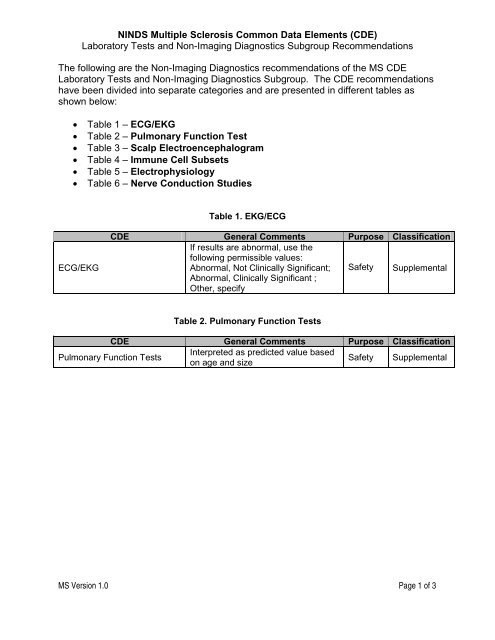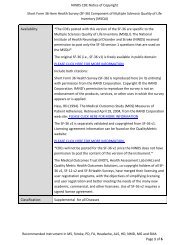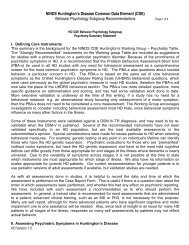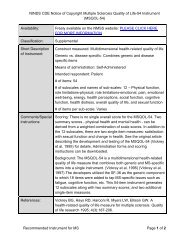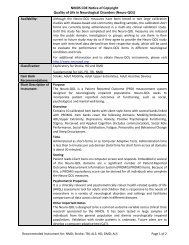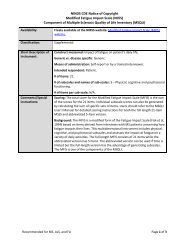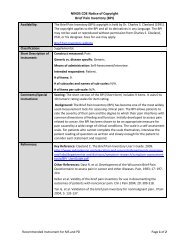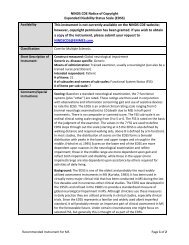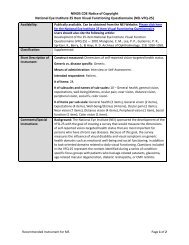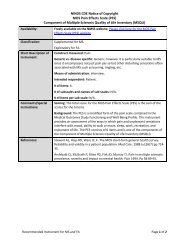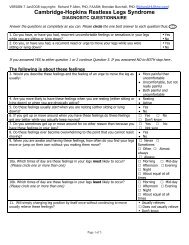NINDS Multiple Sclerosis Common Data Elements (CDE ...
NINDS Multiple Sclerosis Common Data Elements (CDE ...
NINDS Multiple Sclerosis Common Data Elements (CDE ...
You also want an ePaper? Increase the reach of your titles
YUMPU automatically turns print PDFs into web optimized ePapers that Google loves.
<strong>NINDS</strong> <strong>Multiple</strong> <strong>Sclerosis</strong> <strong>Common</strong> <strong>Data</strong> <strong>Elements</strong> (<strong>CDE</strong>)Laboratory Tests and Non-Imaging Diagnostics Subgroup RecommendationsThe following are the Non-Imaging Diagnostics recommendations of the MS <strong>CDE</strong>Laboratory Tests and Non-Imaging Diagnostics Subgroup. The <strong>CDE</strong> recommendationshave been divided into separate categories and are presented in different tables asshown below:• Table 1 – ECG/EKG• Table 2 – Pulmonary Function Test• Table 3 – Scalp Electroencephalogram• Table 4 – Immune Cell Subsets• Table 5 – Electrophysiology• Table 6 – Nerve Conduction StudiesTable 1. EKG/ECGECG/EKG<strong>CDE</strong> General Comments Purpose ClassificationIf results are abnormal, use thefollowing permissible values:Abnormal, Not Clinically Significant; Safety SupplementalAbnormal, Clinically Significant ;Other, specifyTable 2. Pulmonary Function Tests<strong>CDE</strong> General Comments Purpose ClassificationInterpreted as predicted value basedPulmonary Function TestsSafety Supplementalon age and sizeMS Version 1.0 Page 1 of 3
<strong>NINDS</strong> <strong>Multiple</strong> <strong>Sclerosis</strong> <strong>Common</strong> <strong>Data</strong> <strong>Elements</strong> (<strong>CDE</strong>)Laboratory Tests and Non-Imaging Diagnostics Subgroup RecommendationsActivating procedures usedTable 3. Scalp Electroencephalogram<strong>CDE</strong> General Comments Purpose ClassificationPermissible values: Sleep;Diagnosis/Hyperventilation; Photic stimulation;SupplementalSafetyUnknown; Other, specifyBehavioral states recordedDate EEG recordedDuration, if prolongedFrequency of the posteriordominant rhythm duringrelaxed wakefulnessLocationNumber of seizures with EEGonlyNumber of seizures withVideo and EEGNumber of seizures with videoonlyOriginal purpose of EEGPosterior dominant rhythmpresent?Total number of seizuresrecordedTypeVideo?Permissible values: Awake; Asleep;Unresponsive state; Indeterminate;Other, specifymm/dd/yyyyPermissible values: Less than 24hours; Greater than or equal to 24hours; N/A; Other, specifyRound to the nearest 0.5 HzPermissible values: Outpatient EEGLab; Inpatient Monitoring Unit;Intensive Care Unit; Ambulatory;Other, specifyPermissible values: Researchpurposes - prospective; Researchpurposes - retrospective; Clinicalpurposes; Other, specifyPermissible values: Yes; NoPermissible values: Routine;ProlongedPermissible values: Yes; No;Unknown; Other, specifyDiagnosis/SafetyDiagnosis/SafetyDiagnosis/SafetyDiagnosis/SafetyDiagnosis/SafetyDiagnosis/SafetyDiagnosis/SafetyDiagnosis/SafetyDiagnosis/SafetyDiagnosis/SafetyDiagnosis/SafetyDiagnosis/SafetyDiagnosis/SafetySupplementalSupplementalSupplementalSupplementalSupplementalSupplementalSupplementalSupplementalSupplementalSupplementalSupplementalSupplementalSupplementalMS Version 1.0 Page 2 of 3
<strong>NINDS</strong> <strong>Multiple</strong> <strong>Sclerosis</strong> <strong>Common</strong> <strong>Data</strong> <strong>Elements</strong> (<strong>CDE</strong>)Laboratory Tests and Non-Imaging Diagnostics Subgroup RecommendationsTable 4. Immune Cell Subsets<strong>CDE</strong> General Comments Purpose ClassificationCD2+ T cell % and number Other/ Safety ExploratoryCD2+DR T cell % and number Other/ Safety ExploratoryCD3+/CD4+ T cell % and number Other/ Safety ExploratoryCD3+/CD8+ T cell % and number Other/ Safety ExploratoryCD3-/CD56+ (NK cells) Other/ Safety ExploratoryCD3-/CD56+ brightAbsolute number or proportionalNK cellsOutcome/SafetyExploratoryCD3+ (T cells) T cell % and number Other/ Safety ExploratoryCD4/CD8 ratio Other/ Safety ExploratoryCD4+DR T cell % and number Other/ Safety ExploratoryCD8+DR T cell % and number Other/ Safety ExploratoryCD14+ (monocytes) Other/ Safety ExploratoryCD19+ (B cells) B cell % and number Other/ Safety ExploratoryOther mononuclear subsets Other/ Safety ExploratoryTable 5. Electrophysiology<strong>CDE</strong> General Comments Purpose ClassificationMotor EP: Arm, right and Results should include: latency, Diagnosis/left cortex - APBamp, CMCT, thresholdOutcomeSupplementalMotor EP: Leg, right and Results should include: latency, Diagnosis/left cortex - EDBamp, CMCT, thresholdOutcomeSupplementalMotor EP: Leg, right and Results should include: latency, Diagnosis/left cortex - TAamp, CMCT, thresholdOutcomeSupplementalVEP checkerboard size 16N75 latency; P100 latency; Diagnosis/N145 latencyOutcomeSupplementalVEP checkerboard size 32N75 latency; P100 latency; Diagnosis/N145 latencyOutcomeSupplementalTable 6. Nerve Conduction Studies<strong>CDE</strong> General Comments Purpose ClassificationFwave studies (right and Permissible values: Peroneal Diagnosis/left; M-latency, F-latency) (EDB); Peroneal (TA); Median OutcomeSupplementalMedian Right and Left Segment: abductor pollicis Diagnosis/(amp, latency, CV, temp) brevis (wrist right and left) OutcomeSupplementalSegment: extensor digitorumPeroneal (amp, latency,Diagnosis/brevis (ankle right and left); TACV, temp)Outcome(ankle right and left)SupplementalMS Version 1.0 Page 3 of 3


